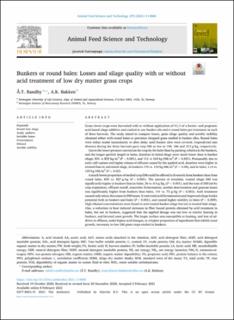| dc.description.abstract | Grass clover crops were harvested with or without application of 4 L/t of a formic- and propionic acid-based silage additive and ensiled in one bunker silo and 6 round bales per treatment in each of three harvests. The study aimed to compare losses, grass silage quality and aerobic stability obtained either with round bales or precision chopped grass ensiled in bunker silos. Round bales were either sealed immediately or after delay until bunker silos were covered. Unpredicted rain showers during the three harvests gave crop DM as low as 194, 186 and 213 g/kg, respectively. Due to the lower pressure exerted on the crop by the baler than by packing vehicles in the bunkers, and the longer particle length in bales, densities in baled silage were much lower than in bunker silage, 531 vs 833 kg/m3 (P < 0.001), and 111 vs 164 kg DM/m3 (P < 0.001). Presumably due to early cell rupture and higher release of effluent caused by the applied acid, densities were higher in treated than in untreated silage, in bunkers 170 vs. 159 kg DM/m3 (P = 0.08), and in bales, 114 vs. 109 kg DM/m3 (P = 0.02). A much lower proportion of ensiled crop DM could be offered to livestock from bunkers than from round bales, 833 vs. 927 g/kg (P < 0.001). The amount of moulded, wasted silage DM was significantly higher in bunkers than in bales, 26 vs. 0.6 g/kg, (P < 0.001), and the sum of DM lost by crop respiration, effluent runoff, anaerobic fermentation, aerobic deterioration and gaseous losses was significantly higher from bunkers than bales, 141 vs. 72 g/kg (P < 0.002). Acid treatment caused only minor decreases in DM losses. It restricted acid fermentation and improved silage intake potential both in bunkers and bales (P < 0.001), and caused higher stability in bales (P < 0.009). High ethanol concentrations were found in acid treated bunker silage but not in treated bale silage. Also, a reduction in heat induced increases in fiber bound protein obtained by acid treatment in bales, but not in bunkers, suggested that the applied dosage was too low to restrict heating in bunkers, and favored yeast growth. The larger surface area susceptible to heating, and loss of ad ditive in effluent, make higher acid dosages, or a higher proportion of ingredients that inhibit yeast growth, necessary to low DM grass crops ensiled in bunkers. | en_US |

